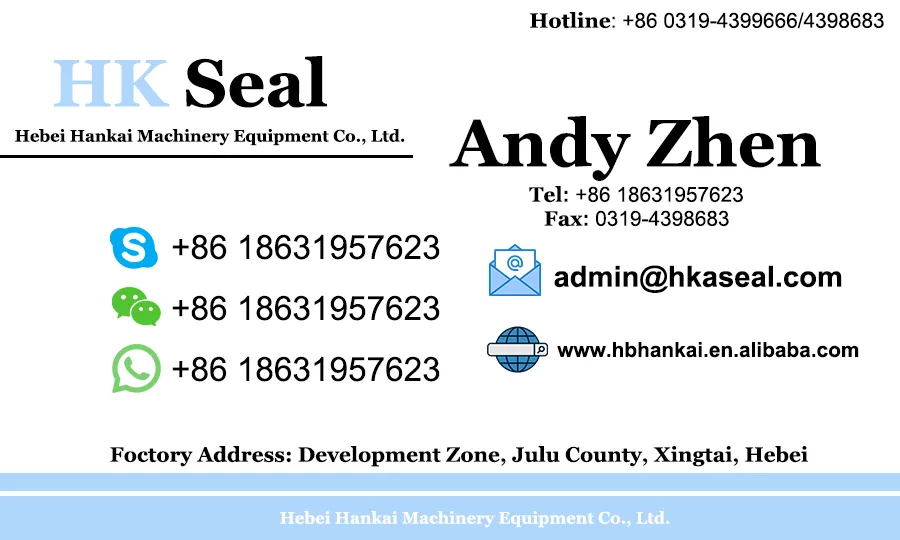снеж . 11, 2024 02:58 Back to list
High-Performance Rotary Shaft Seals for Extreme Pressure Applications and Efficiency
High Pressure Rotary Shaft Seals An Overview
High pressure rotary shaft seals are critical components in various mechanical systems where rotating shafts pass through stationary housing. These seals are designed to prevent the leakage of fluids—such as oil, water, or other process media—while maintaining the integrity of the machinery and ensuring its efficient operation. Whether in automotive applications, hydraulic systems, or industrial equipment, the reliability of these seals is paramount.
Understanding Rotary Shaft Seals
Rotary shaft seals, often referred to as oil seals, are devices installed to retain lubricants and exclude contaminants from entering the machinery. They are commonly made from elastomers (rubber or plastic), metals, or composite materials, ensuring they can withstand different pressure ranges, temperatures, and environmental conditions. At high pressures, the sealing mechanism becomes significantly more complex, necessitating advanced design considerations and material selection.
The primary function of high pressure rotary shaft seals is to form a barrier between the rotating shaft and the surrounding environment. This barrier prevents leakage from the inner chamber, which may be under pressure, while also ensuring that external contaminants do not enter the system. High quality seals not only enhance the longevity of machinery but also promote energy efficiency by reducing fluid losses.
Challenges in High Pressure Applications
High pressure environments pose several challenges for rotary shaft seals. One of the main concerns is the potential for seal failure due to excessive pressure differentials. As pressure increases, so does the force acting on the seal. If the material used for the seal cannot withstand this force, it may deform or wear prematurely, leading to leaks.
Additionally, there are challenges related to temperature variations. Many high pressure applications also involve significant temperature fluctuations, which can affect the physical properties of the seal material. It’s crucial to choose materials that can maintain their elasticity and sealing capabilities over a wide range of temperatures.
Another critical factor is the shaft's surface condition. A rough or improperly finished shaft can lead to premature wear of the seal lip, compromising its sealing ability. Therefore, maintaining optimal shaft conditions through regular maintenance is vital for ensuring the longevity of the seals.
Material Selection
high pressure rotary shaft seals

The choice of material in high pressure rotary shaft seals is decisive. Common materials include nitrile rubber (NBR), fluorocarbon (FKM), and polyurethane (PU). Each of these materials has its own strengths and weaknesses
- Nitrile rubber (NBR) Known for its excellent oil resistance and overall versatility, NBR is often used in oil and grease applications. However, it may not perform well in high-temperature scenarios.
- Fluorocarbon (FKM) This material provides exceptional heat and chemical resistance, making it ideal for more demanding applications. While more expensive than NBR, its longevity in harsh environments can justify the cost.
- Polyurethane (PU) Renowned for its abrasion resistance, PU is often used in applications involving heavy wear and tear. While it has good heat resistance, it may not be as chemically resistant as NBR or FKM.
Choosing the right material depends on the specifics of the application, including the type of fluid being sealed, the operational temperatures, and the pressure conditions.
Innovations in Sealing Technology
Recent advancements in sealing technology have led to the development of high performance rotary shaft seals that can operate effectively under extreme conditions. Innovations such as multi-lip designs, dynamic sealing systems, and enhanced surface finishes for shafts are being researched and implemented in the industry. Multi-lip seals, for example, provide additional barriers to fluid escape and contamination ingress, significantly improving seal performance.
Additionally, the integration of modern manufacturing techniques, such as precision molding and computer-aided design, has allowed for the creation of seals that fit more snugly and perform better over time. These advancements not only extend the life of the seals but also reduce the frequency of maintenance and replacement, leading to cost savings for operations.
Conclusion
High pressure rotary shaft seals are essential for the efficient and reliable operation of a wide array of machinery. Despite the challenges posed by high pressure environments, innovations in material science and engineering design continue to enhance their performance. By selecting the appropriate seal for a given application and ensuring proper installation and maintenance, industries can significantly reduce the risks associated with leakage and extend the service life of their equipment. As technology progresses, we can expect even more advancements in the reliability and effectiveness of rotary shaft seals, securing their place as integral components in modern mechanical systems.
-
The Trans-formative Journey of Wheel Hub Oil Seals
NewsJun.06,2025
-
Graphene-Enhanced Oil Seals: Revolutionizing High-Pressure Oil Sealing
NewsJun.06,2025
-
Future of Hydraulic Sealing: Advanced Intelligent TCN Oil Seals
NewsJun.06,2025
-
Don’t Let a Broken TCV Oil Seal Ruin Your Day
NewsJun.06,2025
-
Bio-Inspired Dust Seals for Better Sealing Performance
NewsJun.06,2025
-
Biodegradable and Sustainable Hydraulic Seal Materials
NewsJun.06,2025
-
Top Oil Seal Solutions for Your Industrial Needs
NewsMay.22,2025
Products categories
















